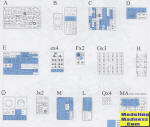
Dragon 1/35 Pzkpfw IV ausf F2
| KIT #: | 9019 |
| PRICE: | $ |
| DECALS: | Multiple optionsNone |
| REVIEWER: | Scott Van Aken |
| NOTES: | 1996 boxing. |

| HISTORY |
On 26 May 1941, mere weeks before Operation Barbarossa, during a conference with Hitler, it was decided to improve the Panzer IV's main armament. Krupp was awarded the contract to integrate again the 50 mm (1.97 in) Pak 38 L/60 gun into the turret. The first prototype was to be delivered by 15 November 1941. Within months, the shock of encountering the Soviet T-34 medium and KV-1 heavy tanks necessitated a new, much more powerful tank gun. In November 1941, the decision to up-gun the Panzer IV to the 50-millimetre (1.97 in) gun was dropped, and instead Krupp was contracted in a joint development to modify Rheinmetall's pending 75 mm (2.95 in) anti-tank gun design, later known as 7.5 cm Pak 40 L/46.
Because the recoil length was too great for the tank's turret, the recoil mechanism and chamber were shortened. This resulted in the 75-millimetre (2.95 in) KwK 40 L/43. When the new KwK 40 was loaded with the Pzgr. 39 armor-piercing shell, the new gun fired the AP shell at some 750 m/s (2,460 ft/s), a substantial 74% increase over the howitzer-like KwK 37 L/24 gun's 430 m/s (1,410 ft/s) muzzle velocity. Initially, the KwK 40 gun was mounted with a single-chamber, ball-shaped muzzle brake, which provided just under 50% of the recoil system's braking ability. Firing the Panzergranate 39, the KwK 40 L/43 could penetrate 77 mm (3.03 in) of steel armor at a range of 1,830 m (6,000 ft).
The longer 7.5 cm guns were a mixed blessing. In spite of the designers' efforts to conserve weight, the new weapon made the vehicle nose-heavy to such an extent that the forward suspension springs were under constant compression. This resulted in the tank tending to sway even when no steering was being applied, an effect compounded by the introduction of the Ausführung H in March 1943.
The Ausf. F tanks that received the new, longer, KwK 40 L/43 gun were temporary named Ausf. F2 (with the designation Sd.Kfz. 161/1). The tank increased in weight to 23.6 tonnes (26.0 short tons). Differences between the Ausf. F1 and the Ausf. F2 were mainly associated with the change in armament, including an altered gun mantlet, internal travel lock for the main weapon, new gun cradle, new Turmzielfernrohr 5f optic for the L/43 weapon, modified ammunition stowage, and discontinuing of the Nebelkerzenabwurfvorrichtung in favor of turret mounted Nebelwurfgeraet. Three months after beginning production, the Panzer IV Ausf. F2 was renamed Ausf. G.
| THE KIT |
 One
of the mainstays of the Dragon line has been the Panzer IV. While this may not
be one of the first they kitted, its 1996 date means it is pretty close. It is
also one of their tanks that has the individual track links, a feature that
makes up much of the 553 parts that are in the box.
One
of the mainstays of the Dragon line has been the Panzer IV. While this may not
be one of the first they kitted, its 1996 date means it is pretty close. It is
also one of their tanks that has the individual track links, a feature that
makes up much of the 553 parts that are in the box.
The lower hull has the suspension attachment points clearly marked and one simply adds the front and rear plates before moving on to the rest of the suspension. Each pair of road wheels attaches to its suspension and then to the hull. Same with the return rollers.
The upper hull has all four sides attaching to the upper section and this, in turn, attaches to the fenders. The very forward bit is attached to the lower hull and before one glues the upper hull in place, the tracks need to be assembled and installed. One then goes on to attach all the various pioneer tools as well as the spare links and other bits.
The turret is the last item to built. the gun has no breech though you can have the hatches open if you wish to install a figure. As I've seen on some other tank kits, there are bolt heads molded on the sprue that will need to be cut away and attached to a few spots on the turret.
Instructions are well done with Gunze paint references. There are Four markings options. One is the cover tank with the14 Panzer Division in 1942. Another is an all panzer yellow version with the 'LAH' Division in Paris in 1942. The others are with the 15th Panzer Division in Africa, also overall panzer yellow and the last is with 22 Panzer Division in Kursk during 1943. This final tank is in a winter wash. Decals don't look bad, but since they chose to use a white backing with white lettering, showing you anything would be pretty useless. This sheet is for several kits as it has more than two markings options.
| CONCLUSIONS |
It is not difficult to find older Dragon kits from show vendors and for considerably less than retail. If you are a 1/35 armor fan, you should seek this one out.
| REFERENCES |
https://en.wikipedia.org/wiki/Panzer_IV#Ausf._F2_to_Ausf._J
October 2017
Copyright ModelingMadness.com. All rights reserved.
If you would like your product reviewed fairly and fairly quickly, please contact the editor or see other details in the Note to Contributors.
Back to the Main Page Back to the Previews Index Page Back to the Review Index Page